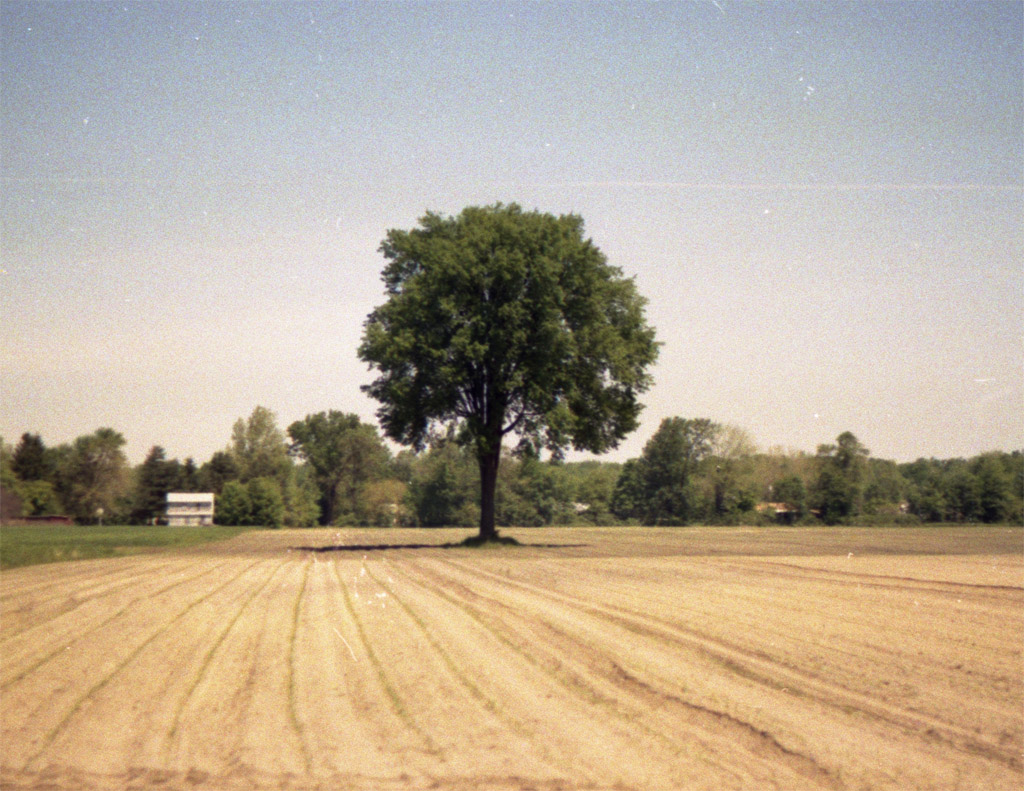Wherever the countryside has historically consisted of small farms, the image of orderly rectangular fields, knitted into a sprawling fabric by a network of shrubby fencerows, has embedded itself in the collective aesthetic of those who live among them. The farmer’s field, one could say, is cut from the same cloth as the painter’s canvas — stretched taut between fenceline and forest, it is annually primed by the methodical pass of the plow, to take on alternating turns of gray, then green, then gold, in a grand performance of the ultimate plein air.
But as easily as even the most ordinary field combines the geometry of Mondrian with the scale of Christo, there are some that go on to tease Magritte. These are the fields where, standing off in a seemingly random spot, is an ancient, solitary tree — its stark and singular presence an exuberant counterpoint to the passive terrain it has somehow come to survey. Looming over an otherwise featureless expanse that has since been groomed to express its summer thought in corn, or soy, or wheat alone, the interjection of a towering tree and its unkempt apron of random weeds is a strange digression — a ghost, perhaps, of the forest that went before — or a daydream, of one that might again, one day.
The frugal farmer is certainly aware of the shadows they cast on his crops, and the obstructions their roots and branches present to the plow and the tractor cab. So to what set of curious circumstances do we owe the presence, and persistence, of these impertinent outbursts of the otherwise obedient plain?
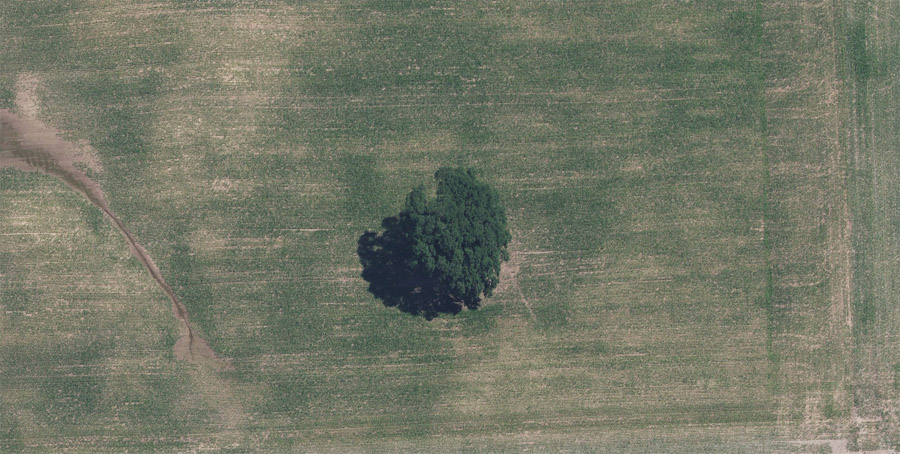
Alone, but not lonely
My own account of rural life teaches that many a rural child has been left alone at times, to roam the indifferent fields nearby. It is also true that one, at least, came to find a field tree an apt companion with which to while away an unstructured afternoon.
To roam an empty field would have been a dreadful bore, akin to floating on a raft in the sea. Thus it was that a suitably positioned field tree could easily take on the allure of a desert island; as much, at least, as a Midwestern child might conjure up from the geography at hand. Its height and girth were proof that it had persisted here for longer than any of us could know, its roots and branches preserving a lens-shaped sliver of virgin ground that had never been turned by a disc or a plow, shading just enough space for a castaway of a summer afternoon to comfortably scan the horizon for a passing ship. Or as easily, it was that mighty ship, its limbs and leaves its masts and sails, conspiring with the gentle Westerlies to transport this patch of ground to anywhere but here.
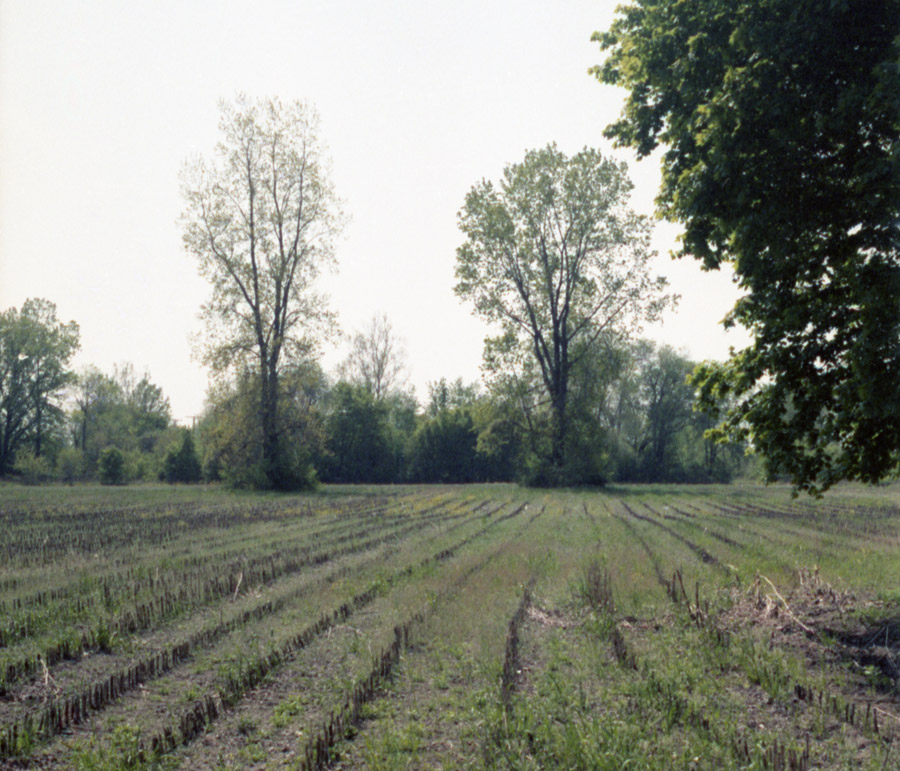
As he cut across the field, stumbling upon clods of jumbled earth, filling his shoes with the silt of a dusty tillage, or later in rows of corn immersed, the leafy murmur of the fencerows he left behind would diminish to an unnatural silence until, approaching ever closer, only the gently quaking crown of a colossal tree could be heard, as it idly reached its fingers into an invisible breeze above. This was the lofted breeze that only the tallest treetops knew; it was the same everpresent flow that hawks could find and glide upon even on the calmest day, and that we knew would hold our kites aloft if our running feet could coax them high enough. Here, with every gathering gust he could hear the sound of a single tree — and as if it were a tin can on a string, he eavesdropped on its conversation with the freedom it touched above.
Admired from afar
Even when only glimpsed from a passing car, the field tree bears a ready admiration on its sleeve; one that readily brushes off upon casual passersby. Singularity is its defining feature, and the trait that sets it apart. Confidently displayed, the spectacle of its very aloneness is the draw of our attention, and through this attention it proves that an admirable singularity need not be lonely at all.
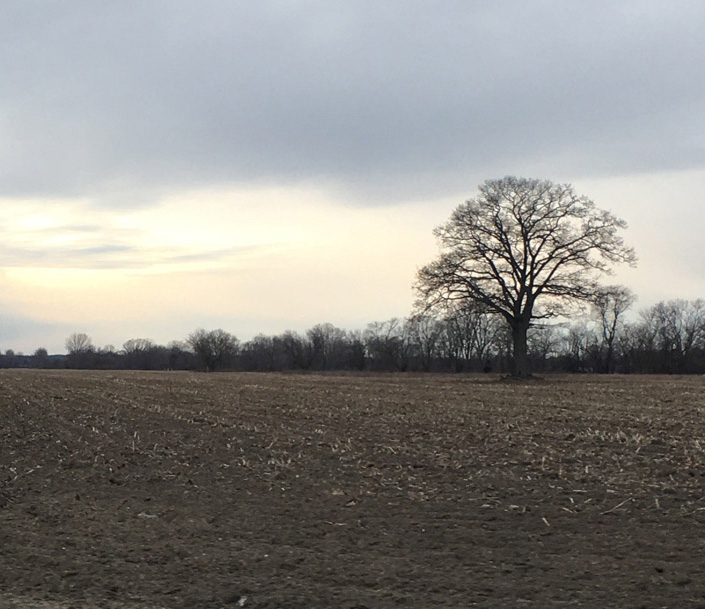
“I am no more lonely than a single mullein or dandelion in a pasture, or a bean leaf, or sorrel, or a horse-fly, or a bumble-bee. I am no more lonely than the Mill Brook, or a weathercock, or the north star, or the south wind, or an April shower, or a January thaw, or the first spider in a new house.”
— Henry David Thoreau
Indeed, as Thoreau suggests, we are sometimes never so lonely as when among our own kind. “We are for the most part more lonely when we go abroad among men than when we stay in our chambers,” he said in Walden. A curious perspective, one might think; but the example of a tree can help us understand what he means. Among its uncountable cohorts in forest or fencerow, any given tree is anonymous and unnoticed, its individuality unseen and irrelevant. But alone in a field, it can explore the possibilities of its growth habit most faithfully, freed from the distractions and distortions brought by the competition of its peers.
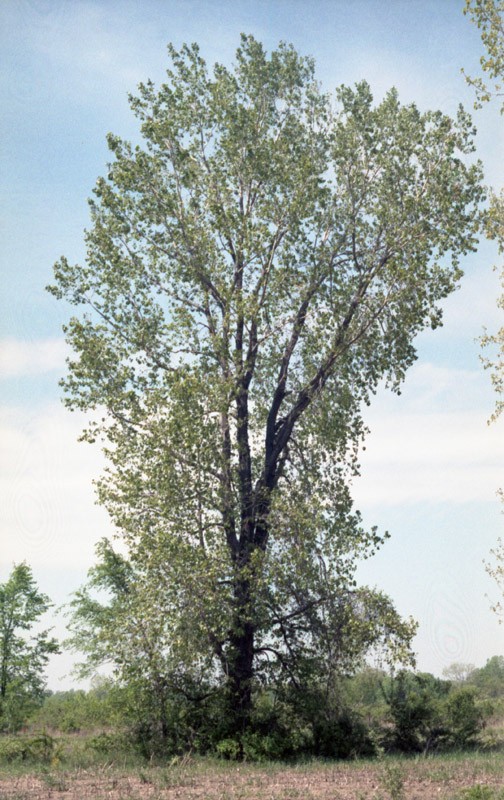
The result is not at all a standoffish hermit; a visit to a lone tree in a field is an encounter with a vibrant and sociable spirit, ready with countless prods to the imagination. On the ground, buttressing knuckles of root may poke up unmolested here and there; a patch of moss or lichen might tell of a shadier side, confirmed by a bare patch of dirt. A collection of field stones might be strewn about, flung from the furrows long ago by a succession of cursing ploughmen; a patch of grass between them might be slightly flattened from a previous visit by a deer or another wandering sort, a day or a week before. Patches of smooth and rough sort themselves out along the knurled bark as it stretches skyward in pursuit of a brighter glint of sun, becoming increasingly dappled as it gradually finds the sky. Somewhere below, a trench left by the plow sharply severs the turf, defining this year’s boundary between the working and the left-to-be.
Much like the knothole tree in To Kill a Mockingbird, where a reclusive Boo hid trinkets for Jem and Scout, a prominent but otherwise neglected tree holds a natural appeal to those with treasures to hide, or to seek. The urge to collect items and experiences belonging only to oneself is one of the earliest behaviors by which our individuality begins to emerge. Hidden in the plainness of sight, a solitary field tree, not too far from the house, has often been discovered as an ideal place where one might forge a small world of one’s own under the eye — but not the watchful scrutiny — of the mass of others who are not so attuned. Pressed into service as a playhouse and sovereign state, it transcends from an ordinary tree to become part of the intangible cultural heritage of a family home.
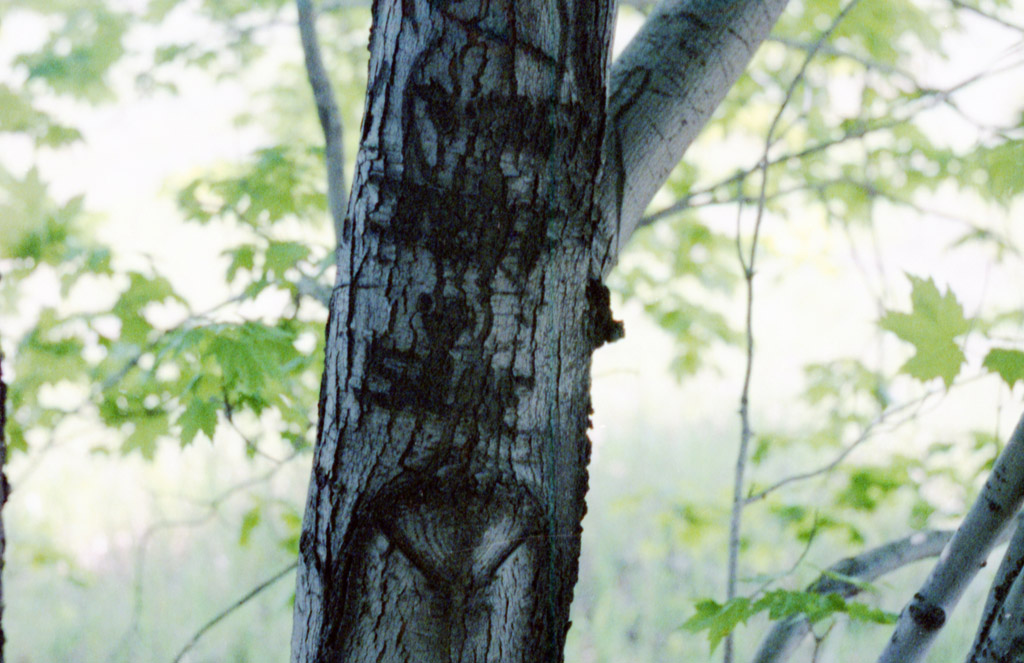
Six years after my family left its longtime home when I was still a young teenager, I had acquired a used car and some extra cash, and early one spring my first cross-country trip led me back to its abandoned grounds. There I walked among the weathered stubble of my family’s five-acre cornfield, freshly wintered-over from a leasing farmer’s autumn harvest, bursting bashfully anew in hesitant shades of green, as it spooled up for another summer that I would not be there to see. Yet, the field tree that I had often rested beneath continued to testify to my family’s longtime presence, its trunk now a living artifact, an indecipherable tablet inscribed with notches, nooks and cryptic marks left by jackknives, nails and rope swings, now half-healed over or fully absorbed into puffy scars, once chronicling the history of the rivalries, loves, and other inventions of my older brothers and me, but each now evidence only that some thought had occurred, its content largely lost — just a layer of vague disturbances in a life much longer than ours.
Why are they here?
As evocative as they may be to those who know them, a more prosaic and practical question is why these trees exist at all, not what their existence brings.
The modern farm, at least, bears no sentiment for misplaced trees. In a mindset symptomatic of the poverty of thought that often accompanies business endeavors, an irrational fear of thirsty roots and errant shadows has caused many a fencerow and field tree to be summarily felled by the razor-thin margins of modern agribusiness. To the corporate farmer, the solitary tree is merely a bit of bad brushwork, a loosened camel’s hair fallen from an inferior brush, spoiling a surface too delicate to bear its presence. The composition of a modern field must be austere, and gains no benefit from accent or punctuation.
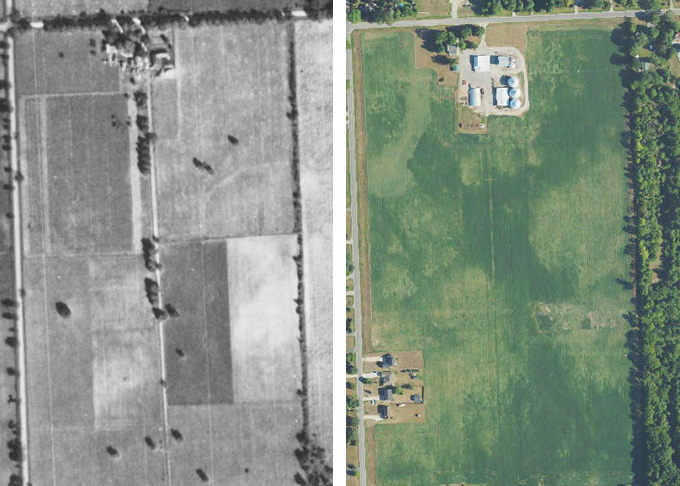
But where they do persist, why has such fortune been cast upon these trees, that they should be free to gather the sun and spread their roots unopposed? And why, so often, is this privilege annually renewed by the farmer’s equally persistent plow?
Older than we think
Wherever a tree springs up and grows to maturity, it is evidence of the providence that is sometimes afforded by random chance: the unguided landing of an airborne seed, the improbable germination and growth of a sapling, and later, a continued pattern of benign neglect by forces that could as easily and as arbitrarily destroy it, until it has grown beyond the reach of a sudden whim to tidy up. If this sequence occurs in a fallow field, and for long enough, the returning farmer might find it a smidgen large to drive the tractor over, and might instead decide to plow around. But to explain how the obvious obstruction of a large field tree builds and holds on to its outlier status for decades or centuries more, something more is needed.
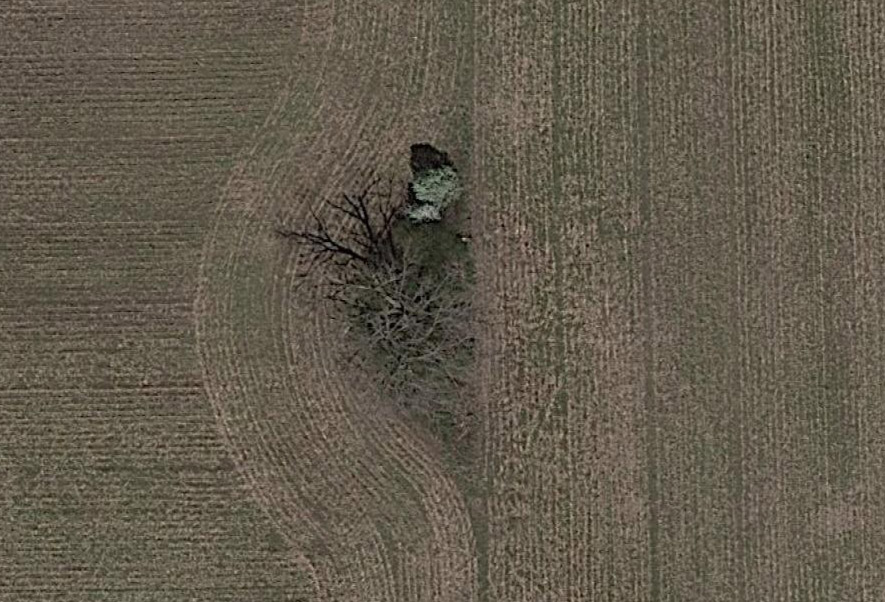
Nobody remembers
Few field trees that are large enough to remark upon can have their presence explained by way of living memory. In particular, the oaks and hickories are often much, much older than we assume. Many have long since survived the grandchildren of those who last knew why they were planted, or saved from the axe — and for these, only speculation can fill the void.
Some have proposed that a solitary tree is meant as a natural lightning rod, to save the crops from burning in case of a storm. Aside from the fact that I’ve never heard of crops being destroyed by lightning, I suspect that a generation of Jerry Bruckheimer films may have something to do with this misconception.
Some speculations are more plausible. Some say that these trees were meant as a convenient, shady place for the farmer to rest his plow-horses while he has a bit of lunch — and this may well be true. But this is only a use, not necessarily a purpose: as a purpose, it requires premeditation — a young pioneer, perhaps, having the foresight to say to himself, “I will leave that sapling, and it will someday shade my horses.” But the forty years or more required for an oak or hickory to become useful shade for a team of horses on a hot summer day is likely beyond the foresight of a struggling homesteader and his hardscrabble life. While saving a mature tree for this purpose is more likely, we must also consider that in many areas of Michigan, the farmers did not arrive until after the loggers had taken every old-growth tree, and so in many fields this option was unavailable.
Others have observed that one or more trees provide useful reference points by which the farmer can see what part of the field he has gotten to with his team. But again, this is only a useful outcome of having these trees, not a likely reason for their existence in the first place — any more than was my childhood penchant for visiting them.
Others say that a solitary tree is evidence of a low-lying spot, which would mire the plow and must be avoided, thus allowing a tree to eventually grow there undisturbed. Undoubtedly this is sometimes the case; I know of instances where a tree or a small wood signals a slough that is often too wet to plow. But this cannot be the only explanation; below, we see a small field grove that is definitely not the low spot of the field, and neither are most that I know.
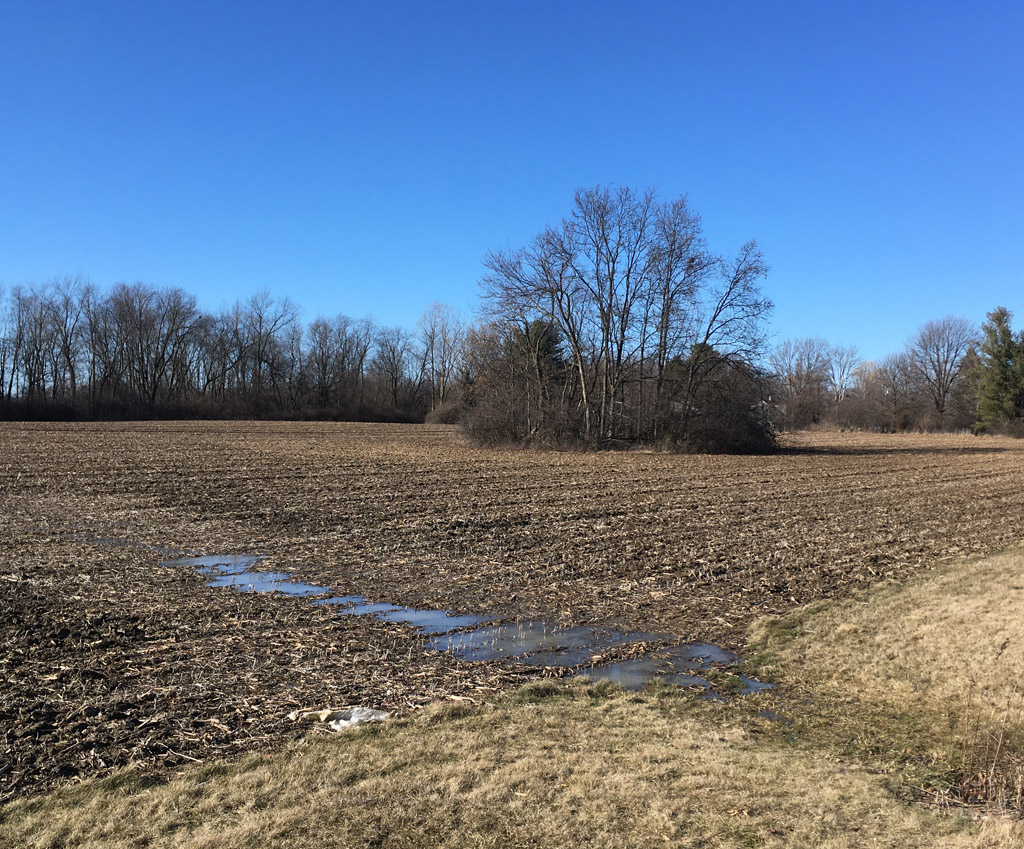
Another circumstance could be a large, immovable rock or other obstruction; perhaps a glacial erratic just under the surface, or the foundation of an old house or barn that has not been removed. I also know of trees whose location lines up perfectly with a former property line, before two fields were merged. When removing the fencerow, its larger trees might have been allowed to remain, for the purpose of shade and so on.
And why would the shade of a single tree even be needed, when leafy fencerows are all around? After all, the average field of long ago was smaller than it is today; one could easily suppose that a shady fencerow would always be near enough to dispense with the need for a standalone tree. But looking at old aerial photos, it seems that many of the fencerows of eighty years ago were quite sparse, as farms were often cultivated to the hilt. The small shrubs that collected there would not offer the same kind of shade as a large, leafy oak, and virtually nothing when the sun is nearly overhead. Even taller trees at the edge of a field are frequently not useful for shade: for example, on the north edge of a field, a tree can provide shade from the mostly southgoing sun only in early morning and at sunset; and on the other edges, only according to the time of day.
But a large tree, stranded in the middle of the field, offers both a central location and a shadow at all times of day, rotating slowly about it like the hands of a clock.
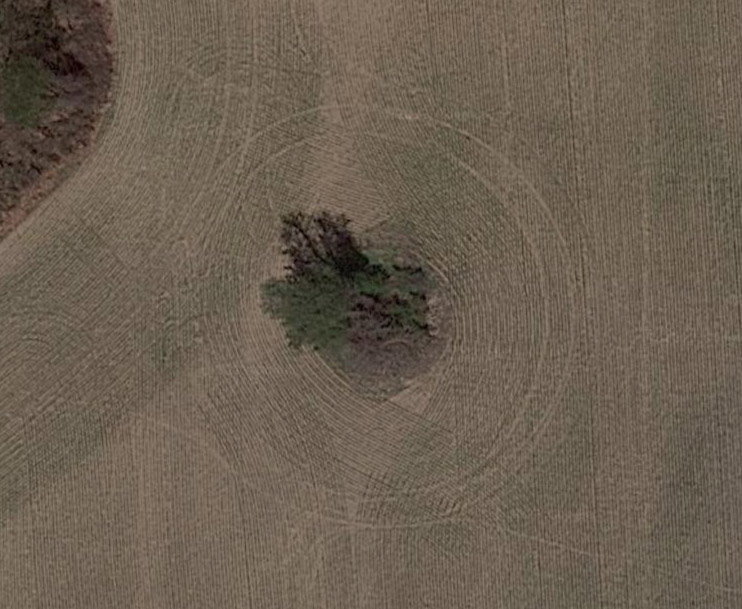
An endangered species
Unless you live on a property that hosts one, a field tree is one of those rare pleasures that cannot adequately be experienced in the proper way — thoughtfully, and alone — without trespassing.
Not that long ago, there were more small farms than there are today, and scattered among them were many small, vacant agricultural tracts not connected with any house — and field trees were a feature of many of them. I was also fortunate that in lower Michigan farm country, or in my home township at least, there seemed to be an unofficial freedom to roam principle, by which any piece of vacant cropland without a house and without a fence or posted signs was understood to be free for a local person to roam. As a child I thereby was able to become acquainted with a number of solitary trees that lingered on the vacant tracts nearby. But as I drive about these areas today, the hundreds of one-off, sub-suburban houses that have sprung up on the outlots of seemingly every agricultural tract have largely taken that right away. It seems that the ability to roam, and to become acquainted with the fencerows and field trees of the countryside whether we own them or not, is rapidly receding from the common rural experience.
But if you see a tall, ancient tree in a park someday, reaching high enough into the sky and separated enough from its neighbors, take a moment to approach it, sit under it, and listen. You might begin to appreciate at least a small part of what many a rural child, and many a resting horse team, got to experience on a clear and calm summer day of long ago: the cool, relaxing sound of a single tree, teasing the summer breeze with a thousand tiny kites — and allowing us to listen for a bit to the exchange, as if it were a tin can on a string.
Part 2: Lone Tree Goes to Town
Article and photos Copyright 2023.
To be notified of new articles, visit https://whatshallweweird.com/subscribe/
